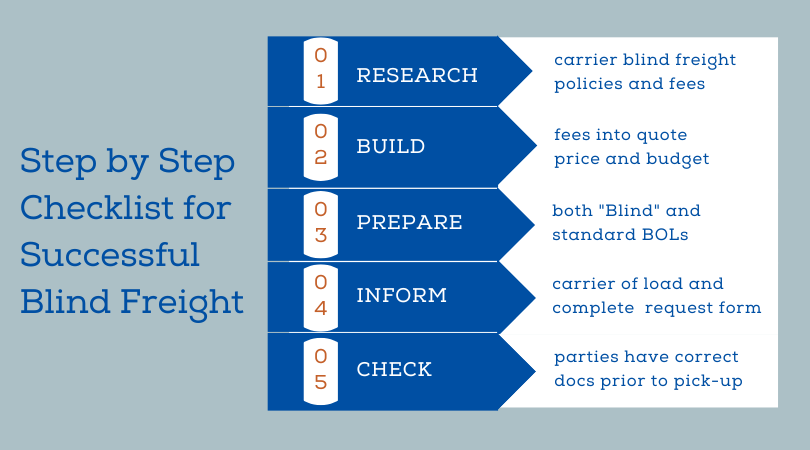3 Blunders That Can Sabotage Your Blind Freight Shipment
09/22/2022 — Jen Deming

LTL freight shipments come in many forms, but one of the most confusing types you may have heard of is blind freight shipping. In blind freight shipping, the identity of the shipper, receiver, or both parties is hidden. It’s most commonly used when a business is shipping orders directly from the manufacturer to the customer.
If you think that sounds complicated, that’s because it is, but there are distinct advantages to taking this route when arranging a freight shipment. The most common reason a business would choose to do this is to keep other parties within your supply chain confidential from your customers, such as manufacturers or distributors. The idea is that they would then be deterred from going directly to those sources for a product instead of your business. Sounds good, right? Well, the challenge is that managing blind freight shipments can get pretty dicey, and most missteps fall within three major areas.
- Blind Freight Paperwork Mistakes
Properly preparing and distributing freight shipping paperwork is a stumbling block for many shippers, on even the most standard loads. In blind shipping, up to three separate BOLs must be prepared, depending on which parties aren’t being disclosed. In double-blind shipping, you will have one for the shipper, one for the receiver, and a conventional BOL for the carrier’s use. All three of the BOLs should include accurate shipment details, including weight, dimensions, and product description.
They should also include accurate freight classes so that the load is billed properly. Each of them will, however, have slight but crucial differences to ensure your blind freight stays “blind”. A shipper’s BOL will have all of the usual info, but also include PO# or other identifying information. The receiver may be omitted in order to keep the customer anonymous. Likewise, on the receiver/customer’s BOL, the supplier’s identifying info and address will be concealed. The carrier BOL must contain all relevant information that is typically used on the BOL, including both shipping parties full information.

Failing to prepare BOLs properly, or handing them off to the incorrect party, can result in major headaches. A shipment can be misrouted or lost, billed incorrectly, or the blind freight’s purpose may even be defeated by accidentally disclosing parties to one another. The best thing you can do when managing a blind freight shipment is confirm that the carrier has all of the accurate details when setting up the shipment, including the true addresses of both shipping parties.
- Not Accounting for the Additional Costs Associated With Blind Freight
It’s always smart to assume that if a shipment has any extra services or needs “special” attention, a carrier is going to add some extra fees for their trouble. Due to blind freight shipping complexity, there are extra costs associated with this service. Every carrier charges different amounts, and we’ve seen them anywhere from $50-$150. Check your carrier’s website to determine costs. As seen here with YRC, cost is stated clearly, as well as instructions to prepare a blind freight shipment per their standards. Research these fees and make sure you’re building them into your budget to avoid surprises.
On top of regular fees for the service, you have to remember that any errors you make when arranging a blind freight load can end up costing you even more. For example, if you handed off the wrong BOL, and the address is incorrect, rerouting and redelivery fees may apply. This can really inflate your final bill, as well as create on-time delivery complications and stress with your customer.
- Not Being Aware of Blind Freight Restrictions
Just as we see with blind freight costs, requirements and restrictions on these types of shipments can vary with each carrier. Some carriers have a pretty relaxed approach, while many need additional paperwork or approval beforehand. It’s always important to notify your carrier that a shipment is blind at the start of the process so that you can iron out details.
Many carriers, such as YRC, require a form or document to be prepared online before pick-up, so that an “official” notice is on file for the request. Carriers may also require paperwork to protect their interests in the case of blind shipping. There may also be a waiver to sign, notifying you that while they will do everything in their power to honor the request, if something goes wrong, it’s not on them. Some may even include stipulations, such as a note that re-delivery will not be attempted due to issues associated with paperwork errors. It really just depends on the shipper, so be sure to visit carrier websites and search for policies on blind freight shipping. If there isn't information made front and center, always download the latest rules tariff and read the fine print. It's not fun, but it may help you avoid mistakes.
 Ensuring You Avoid Any Blind Shipment Blunders
Ensuring You Avoid Any Blind Shipment Blunders While blind freight shipping can sound totally overwhelming, the opportunity to use this type of freight service should be considered for anyone working as a “middleman” between customers and suppliers. A great freight broker can help manage all of the details, including paperwork and communication between all parties to ensure accuracy. With the right assistance, you can be sure that your blind freight shipment will go smoothly. If you think your business might benefit from blind freight shipping, get in contact with a PartnerShip freight expert to learn more.





